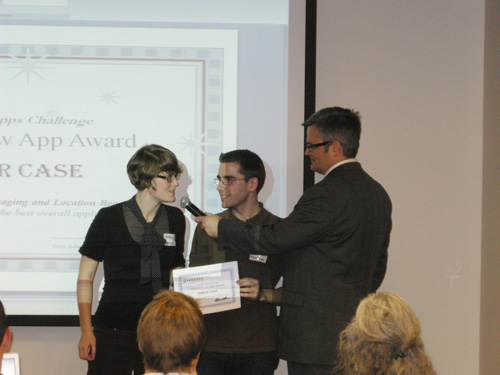 Portland celebrated this week the second round of its CivicApps project, an open source design contest for smart phone applications using Portland data sets to address civic issues.
Portland celebrated this week the second round of its CivicApps project, an open source design contest for smart phone applications using Portland data sets to address civic issues.
By Emma Hall
CivicApps for Greater Portland held an awards ceremony Thursday at Webtrends in downtown Portland. Developers, entrepreneurs and potential investors mingled over hors d’oeuvres and Widmer Brothers kegs before settling down to hear the winners of the contest. Programmers in jeans and T-shirts sat next to entrepreneurs in suits, with multiple front-row attendees videotaping the ceremony on (appropriately enough) their iPhones.
 |
Mayor Sam Adams presents a CivicApps award to Amber Case and Aaron Parecki. |
Awards were given to the apps deemed Most Useful, Most Appealing, Most Original, and Best Use of Data, and then a Best of Show award was picked out of those four winners. The awards (a certificate and $1000 prize) were handed out by city staffer Rick Nixon of the Bureau of Technology and Mayor Sam Adams.
The first award for Most Useful app was presented to local celebrity Amber Case for her “Cross-platform group messaging and location beaconing for disaster relief” app. The app allows users to send an emergency beacon to a real-time map, allowing stranded citizens in the case of a snowstorm or impending earthquake to be found by disaster relief personnel. Mayor Adams indicated that this technology would be useful for the coming cold winter; last winter the city used Twitter during the snowstorm, but people didn’t describe their location accurately enough —a problem that Case’s development would fix.
Cyborg anthropologist Case said she worked on the front-end of the app, and insisted the honor should be shared with PHP developer Aaron Parecki who developed the back-end. “Ah, so you did all the hard work,” Adams said to Parecki as he sipped a Widmer Brothers Drifter IPA.
The Most Appealing award was given to Matt Blair for PDX Trees, an app utilizing a dataset of Portland’s heritage trees. App users can locate the nearest heritage tree on a map and click a link to the Wikipedia page about that particular species, as well as view user-submitted photos of the tree in various seasons. “I love this app because…the more people we can get interested in trees, the better,” Adams said.
The third honor for Most Original was awarded to Melelani Sax-Barnett for her Portland Bike to Transit Map intended to help Portland’s many cyclists find the best routes for transit. Sax-Barnett was not present at the awards, which Nixon postulated was because she was off studying. Her application indicated she was a Portland State University student submitting the fruits of her very first web development effort.
The award for Best Use of Data was given to Max Ogden for his CivicApps Data Previewer. This helps make the CivicApps data more useful to other developers and the public. Even Adams questioned what drew Ogden to this seemingly boring task, to which Ogden insisted that data in a web format makes developers more likely to use it.
Ogden collected datasets on a range of information, from bike lanes to schools to sidewalks (see PDXapi.com/preview). A side project of the work can be seen at ADAPDX.com, which features data dealing with accessibility-such as a map of all the curb cuts on Portland sidewalks for wheelchair-bound individuals. Another side project that Ogden demonstrated at the ceremony was Findsomenature.com, which shows patches of vegetation in Portland (not just from parks) and even a map of urban edibles directing Portlanders to lavender bushes or pear trees on public property.
A special Civic Choice App award was presented to Joseph Mosser for his PDXtrian app. The utility that provides upcoming arrivals and nearby stop locaters for TriMet riders is very popular on the CivicApps website.
The Best in Show award (including an additional $3000) was presented to Case and Parecki. Nixon pointed out that the winning app had been submitted only three minutes before deadline.
Case and Parecki demonstrated their disaster relief utility to the attendees (view it at Loqi.me). Attendees were instructed on how a user could submit a phone number and emergency message, which then showed up on the map on screen as an icon. Perhaps because of the abundance of Widmer on site, suddenly the map began showing a plethora of icons in a cluster in downtown Portland. Emergency messages included such gems as “Where is MC Adams?” and “Help! I need more beer” — a true emergency indeed.
Emma Hall is Web Editor for Oregon Business.

